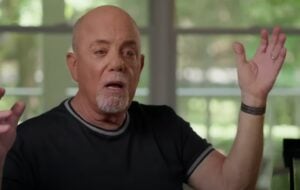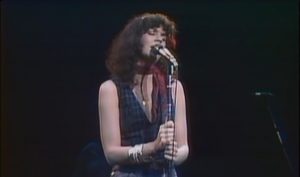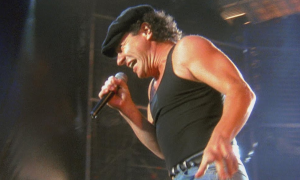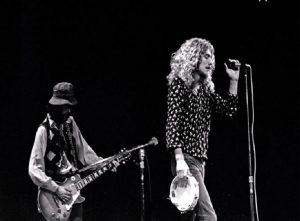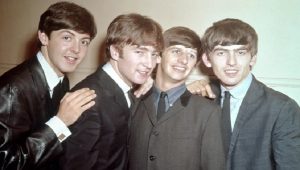The Story Behind ” Dancing In The Dark” By Bruce Springsteen

via Bruce Springsteen / Youtube
Sometime in 1984, an exhausted Bruce Springsteen was sitting on the edge of his bed. Frustrated that he still had to write another song at the behest of his manager Jon Landau, Bruce sits there with anger simmering.
He pens down the 71st song for an album for an album he has been working on for the last two years overnight. Bruce channeled all of these negative emotions into a song that would become his greatest hit, sparking the success that was Born in the USA.
“Dancing in the Dark” was the rock singer’s greatest hit to this day, and it has become one of Rock and Roll Hall of Fame’s 500 Songs that Shaped Rock and Roll. And the story behind its creation and success is still one of rock’s greatest tales.
A song about Bruce’s frustrations
“Dancing In The Dark” by Springsteen reflects his struggle to craft a hit single and the frustration he experienced while attempting to compose songs that would satisfy his audience.
“Jon had been bothering me to write a single, which is something he rarely does,” Springsteen shared in an interview. “But he did that day. And he wanted something direct. That seemed to be what he was hitting on me for at the time. I was angry. I had written a lot of songs and was kind of fed up with the whole thing. We’d been making the record for a long time, and I was bored with the whole situation.”
The lyrics vividly convey his sense of being like a “gun for hire” desperately craving some action. Additionally, he addresses a common industry cliché, one he likely encountered frequently, “They say you gotta stay hungry / hey baby I’m just about starving tonight”.
Ironically, the song became a massive hit – the biggest of his career in terms of its chart performance in the United States.
🎶Bruce Springsteen released ‘Dancing in the Dark’ 39 years ago, May 3, 1984 pic.twitter.com/DYQHL1UOeQ
— RetroNewsNow (@RetroNewsNow) May 4, 2023
The 71st song
This track was the final addition to Born in the U.S.A. Bruce and Landau briefly clashed but he knew his manager had his interest at heart – a classic example of a manager or record executive igniting an artist’s passion and channeling it into a hit, ultimately delivering precisely what they were seeking.
“That particular night, I came home and sat on the edge of my bed, and the thing I remember thinking first was that we had a record, but it wasn’t necessarily finished; I could change the whole thing right now if I wanted to,” the rock icon added.
Springsteen also remembered thinking only one thing during that night, and that was to write as his life depended on it. Dancing in the Dark has become much more than a song assignment, just like he revealed in his 2016 autobiography, “my own alienation, fatigue, and desire to get out from inside the studio, my room, my record, my head and … live.”
The song resonated with listeners, especially those in the US. The US economy was in a slump, jobs had dried up, and it seemed rural America was on the brink of disaster. On June 30, 1984, the song spent its first of four weeks at its No. 2 peak on the Billboard Hot 100. That was Springsteen’s highest showing on the chart as an artist.
Bruce Springsteen. Photo by Richard E. Aaron. pic.twitter.com/4NDJF69IwQ
— Classic Rock In Pics (@crockpics) October 8, 2023
The spark that started the fire that was Born in the U.S.A.
Up to that point, Springsteen had been doing quite well, boasting six successful albums in his discography and an unparalleled reputation for live performances. However, Landau wanted a surefire hit to elevate Springsteen to superstar status.
“Dancing In The Dark” was the spark needed; released as the album’s first single (the only one issued before the album’s release), it set ablaze the success of his seventh album, Born in the U.S.A.
Springsteen’s songs soon inundated the airwaves, and he attracted a whole new audience. Unlike many rock artists accused of selling out when they achieved massive success, Springsteen’s rise to stardom was largely embraced by his dedicated fans, who had spent years spreading his musical gospel.
The American rock icon also gained more fans from the younger generation at that time thanks to the buzz generated by his video, which featured a pre-fame Courtney Cox.
On October 2, 1985, Bruce Springsteen & The E Street Band closed out The Born in the USA Tour at the LA Memorial Coliseum. This was the last of four sold-out nights, bringing in a total of 322,900 fans to the Coliseum. #TodayinColiseumHistory #ColiseumForever pic.twitter.com/IlOMRyZJtq
— Los Angeles Memorial Coliseum (@lacoliseum) October 2, 2023
A music video that features a future star
The resurgence of Springsteen’s life and career is perhaps most evident in the music video for “Dancing In The Dark”, where the beaming rockstar spontaneously invites a young Courtney from the audience to dance with him while the E Street Band performs.
The actress, who would later become known for her role on the wildly popular television show Friends, shared her audition experience for the video during a 2022 interview on The Howard Stern Show.
Cox shared, “I went into [director] Brian De Palma’s office, he put on the music and said, ‘Will you dance?’ I thought, ‘Right now, here, in front of you, just the two of us?’” She recalled feeling incredibly embarrassed, “I think that’s why I got it, because I was literally like [nervously saying], ‘OK.’ I think that’s what they wanted, a fan that just couldn’t believe it.”
Springsteen’s live performances frequently culminate with “Dancing in the Dark”, a song the Financial Times characterizes as a “celebration” although a somewhat somber one. This darkness was somewhat blurred further by the image of a smiling Bruce happily dancing with Courtney.
Bruce Springsteen dancing with a then unknown Courteney Cox, in the video for Dancing in the Dark. pic.twitter.com/HuE5Jtp5Zc
— Classic Rock In Pics (@crockpics) October 2, 2023
A cultural landmark of the 1980s
Born in the U.S.A., released on June 4, 1984 through Columbia Records, quickly became a roaring success and was widely acclaimed by music critics as one of the finest albums ever created.
It received a Grammy Award nomination for the Best Album in 1985 and yielded seven Top Ten singles(the most for any rock album in history) and became the best-selling album of Bruce’s career. A two-year Born in the U.S.A. tour that followed its release was also highly successful.
In terms of commercial success, Born in the U.S.A. achieved staggering heights. It achieved a remarkable 17× Platinum certification from the Recording Industry Association of America (RIAA) for selling over 17 million copies in the United States alone. On a global scale, it has surpassed 30 million copies sold.
As a testament to its lasting appeal, the album left a significant mark as a cultural sensation. Its title track was frequently misconstrued as a patriotic anthem, and the album’s cover art, featuring a close-up of Springsteen with an American flag in the background, captured by Annie Leibovitz, emerged as one of the most iconic and recognizable images in American popular culture.






